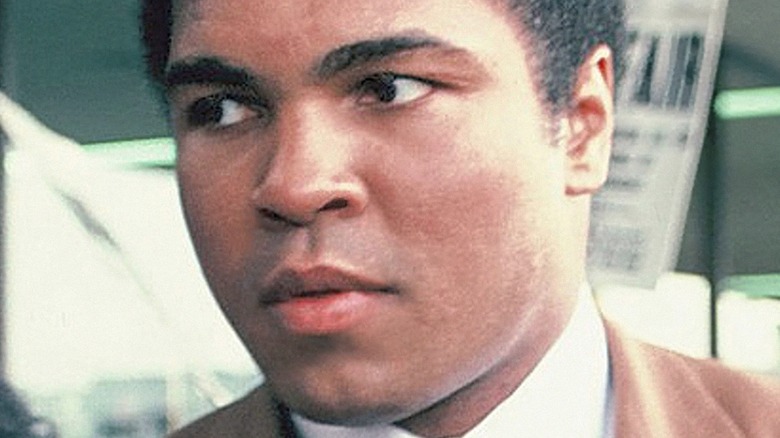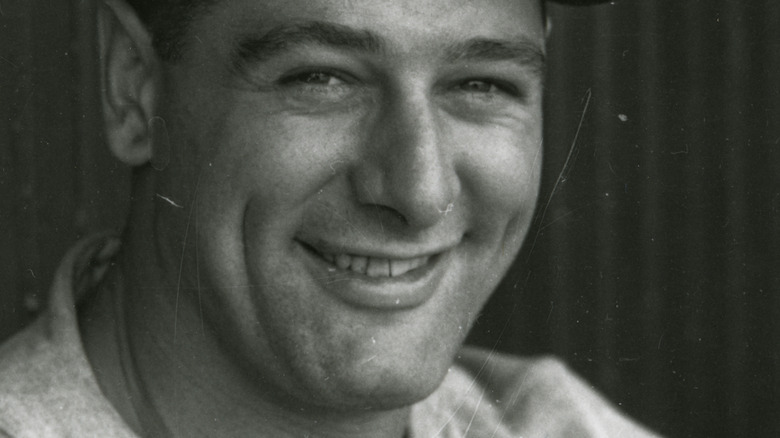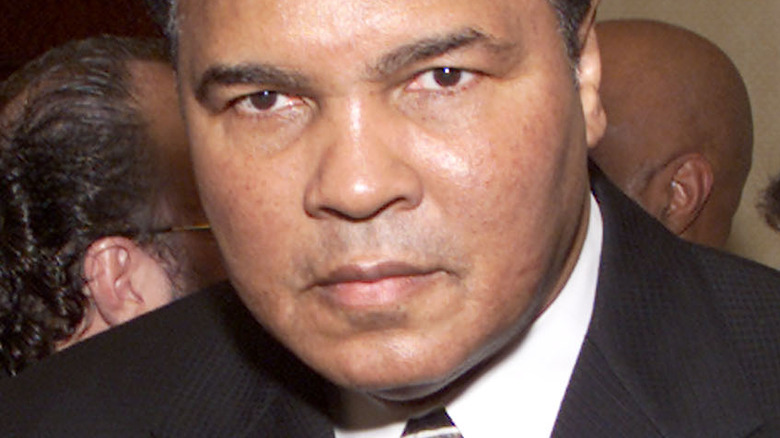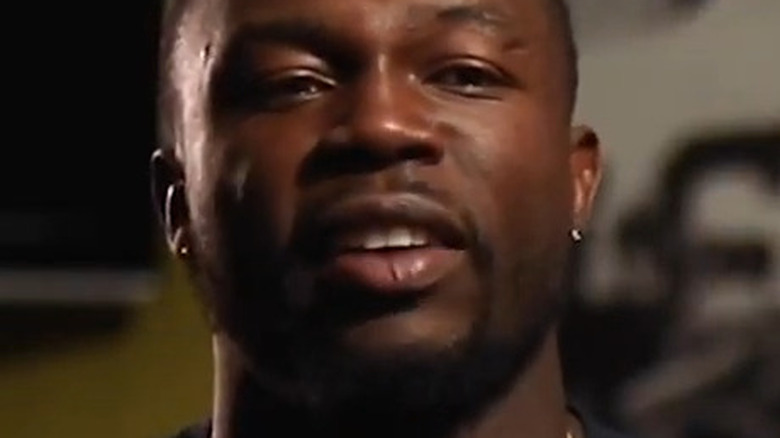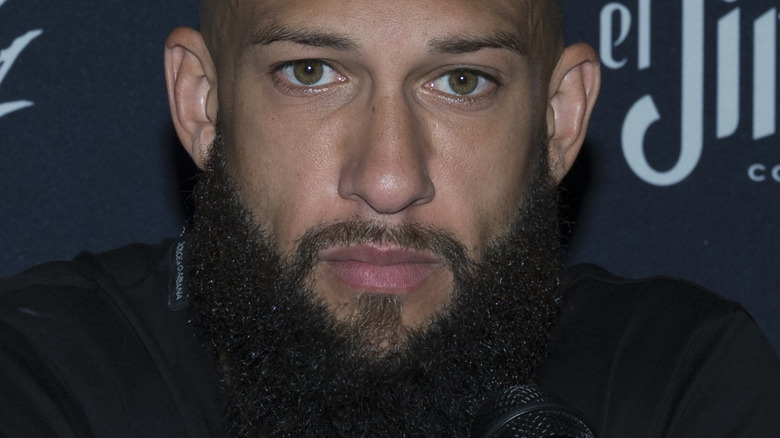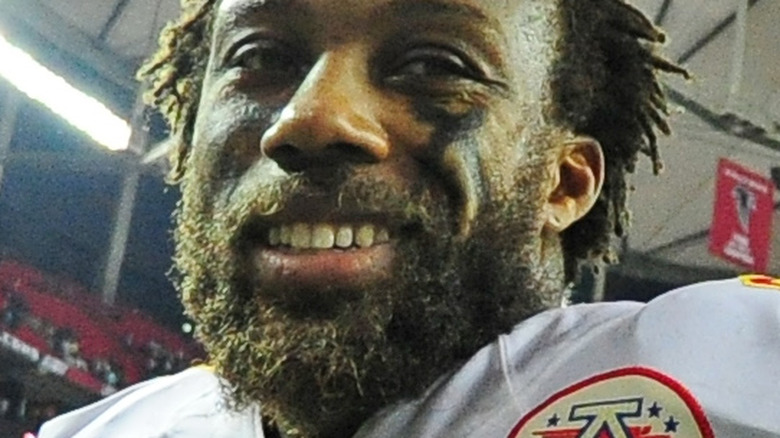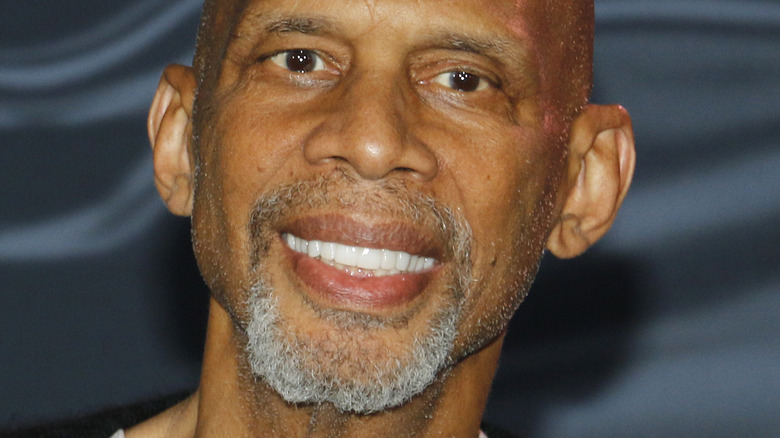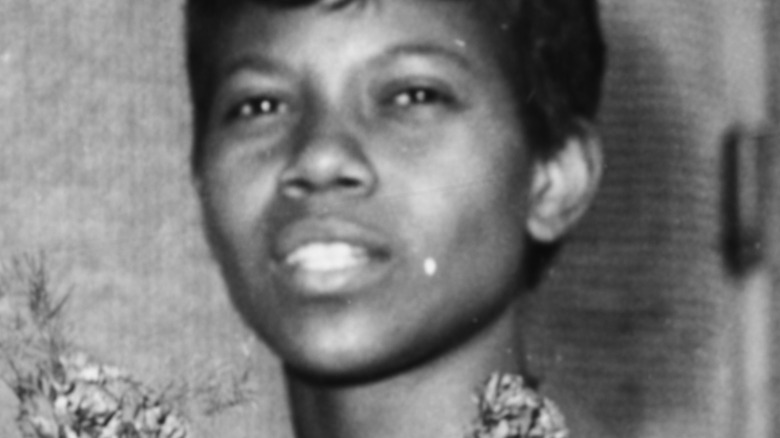Athletes With Rare Medical Conditions
We may receive a commission on purchases made from links.
Athletes are typically people with well-toned bodies capable of achieving great things. That's normally something of a requirement, given their chosen profession. Still, athletes are humans like the rest of us. Despite being capable of many tremendous things, plenty of them suffer from the same diseases and illnesses as the rest of us. That said, there are some athletes who have been diagnosed with rare medical conditions, many of which would keep most people from competing.
Whether they received these diagnoses before becoming a professional athlete or after, many find a way to overcome what would otherwise be debilitating. Granted, there are many whose careers are cut short due to a rare medical condition. Still, more often than not, the stories of athletes afflicted with these conditions center around their paths to overcome them. These kinds of stories often give the rest of us hope because if one person can overcome a condition they have, it might be possible to follow in their footsteps.
There are tons of examples of athletes with common ailments they are able to overcome — just consider how many have torn muscles, tendons, and more. While those stories are inspiring as well, the athletes who've managed to live with something far less common tend to be that much more fascinating and uplifting. All of the athletes in this article have done amazing things in their chosen sport, and each one has or has had a rare medical condition most people wouldn't be able to play through.
Lou Gehrig
Lou Gehrig is one of those names most people know, even if they've never seen a baseball game. He was one of the greatest players of his generation. Gehrig was known for his exceptional hitting skills. At one time, he'd played the most consecutive games in MLB history, a feat which earned him the nickname "the Iron Horse." Gehrig was elected to the Baseball Hall of Fame in 1939, and he holds the honor of being the first player in Major League Baseball history to have his uniform number, which was four, retired.
Gehrig played for the Yankees his whole career, and his exploits were honored in the 1942 Gary Cooper film, "The Pride of the Yankees." Sadly, Gehrig never had a chance to see the movie, as he died in 1941. In 1939, his performance on the field began to diminish due to an as-yet undiagnosed disease called amyotrophic lateral sclerosis, commonly known as ALS — and also Lou Gehrig's disease. ALS is rare, as it afflicts 2 out of 100,000 people, or around 5,000 people in the United States every year.
Gehrig was forced to retire at the age of 36, just years before he died of ALS. After his retirement, the Yankees honored him on July 4, 1939, by holding Lou Gehrig Appreciation Day. He wasn't expected to speak that day, but he made his way to the microphone and said, "For the past two weeks, you've been reading about a bad break. Today, I consider myself the luckiest man on the face of the Earth" (via Daily Beast).
Kayla Montgomery
Kayla Montgomery is a runner whose commitment to her sport is unmatched. She's not the fastest runner or the one with the longest endurance, but she is a runner who commits to each race despite her affliction. When she was 14, Montgomery was diagnosed with multiple sclerosis or MS. This demyelinating disease damages the nerve cell covers of the brain and spinal cord. According to the National Library of Medicine, MS affects 39.5 out of 100,000 people each year and is the most common demyelinating disease.
When Montgomery was diagnosed with MS, she was already on the path to becoming a runner, but she didn't let MS stop her. In fact, running became something of a salvation for the young athlete, which she used as a goal to fight her disease. Her initial attack damaged how she feels her legs, and while therapy can mitigate this for a short time, running brings back the pain and instability in a big way. Despite this, she runs, and it's not uncommon to see her collapse after she finishes a race.
While still in high school, Montgomery ran for her school team, where she took home the state title in the 3,200-meter race. She was also the captain of her team and hopes to teach English and coach track and cross country. Montgomery may not be a professional athlete (yet), but she's an impressive young woman who's overcome her condition to follow her dream.
Muhammad Ali
Muhammad Ali is easily one of the world's most recognized athletes, and even if you never saw him fight, there's a good chance you know who he is. After all, he was The Greatest, and he was a remarkable athlete. He took home the gold at the 1960 Summer Olympics, and four years later, he took the world heavyweight championship title from Sonny Liston. He went on to fight in several historic matches, including his bouts dubbed the "Fight of the Century," the "Thrilla in Manila," and "The Rumble in the Jungle."
Ali was truly one of the greats, and he fought for most of his life. He started learning the sport at 12, won Olympic gold at 18, became the world's heavyweight champion at 22, and didn't retire until 1981, when he was 39. At the time, he was possibly feeling the effects of Parkinson's Syndrome, which he was diagnosed with in 1984. Some doctors claimed his fights contributed to the condition, but those claims have been refuted in recent years.
Ali spent most of his retirement years being active as a guest referee for Wrestlemania, recording spoken word albums, and doing humanitarian work. He also became a heavy influence in the development of hip-hop music. Ali's health gradually declined due to Parkinson's Syndrome. Still, despite his health, he worked to raise awareness through the Michael J. Fox Foundation for Parkinson's Disease. In 2016, Ali died from septic shock at the age of 74.
Antwuan Dixon
Antwuan Dixon was an aspiring football player in high school who dreamed of playing at college, but things took a turn during his sophomore year. Non-vigorous activities left him feeling fatigued. After he fainted while moving his mother's car from the driveway, it was time to see a doctor. That's when Dixon learned he had a rare disease called aplastic anemia. The condition disrupts the body's ability to create blood cells. It caused fainting spells for Dixon due to his inability to spread oxygen throughout his body.
Aplastic anemia is incredibly rare, as it affects two out of every one million people. What's more, it doesn't typically present in patients of Dixon's age group, so the diagnosis itself was unusual. Regardless, Dixon had a rare disease that made it impossible to continue playing football. At least, it certainly should have limited his ability to follow his dream, but he didn't let it. With his family's help, he underwent treatment consisting of a bone marrow transplant, and he made his way back to the gridiron.
Dixon received a scholarship to play for the Kent State Golden Flashes as a wide receiver. He missed two seasons for treatment but was granted a sixth year of eligibility so he could rejoin his team. Of his situation, Dixon said, "I've been able to spread my story around a lot of different places — especially the people who are playing sports and have aplastic anemia or another rare disease" (via Future of Personal Health).
Tim Howard
Tim Howard began playing American soccer in 1997 for the North Jersey Imperials, where he quickly distinguished himself. He continued playing for numerous teams, including the U.S. Men's National Team, where he competed at the highest level. To most fans, Howard is probably the greatest U.S. goalkeeper of all time, and that's not just an opinion — it's backed up by stats. Howard holds numerous records earned throughout his 24-year career. Still, his athletic career isn't all that he's known for around the world.
In an excerpt from Howard's autobiography "The Keeper: A Life of Saving Goals and Achieving Them", via The Guardian, at 11 he was diagnosed with "obsessive-compulsive disorder, or OCD, and Tourette syndrome, TS — a double whammy of brain difference, a worrisome one-two punch." Despite what you've seen in popular culture, both conditions are rare, with TS afflicting 6 of 1,000 male children. OCD is found in around 1% of children, and both conditions can disrupt learning and behavior. Tourette's syndrome is an oft-misunderstood condition that manifests in various ways — not just blurting obscenities. In many people, like Howard, it results in various vocal and motor tics, which can change over time.
Howard's diagnosis helped reorient his education, and he continued playing sports, often excelling. He credits his condition with helping him tend goal, saying he has an enhanced perception. "I could see things somehow, things that other people didn't seem able to" (per The Guardian). Howard has helped raise awareness through a lot of charitable work for TS and is the embodiment of the concept that "TS is a Speed Bump, Not a Stop Sign."
Steven Striegel
Steven Striegel was diagnosed with a rare disease right out the gate. As an infant, Striegel was diagnosed with tuberous sclerosis complex, a condition that impacts cognition and motor skills. Tuberous sclerosis causes tumors to develop throughout the body. While these tumors are benign, they affect several bodily functions and can result in seizures, skin abnormalities, behavioral problems, autism, and issues with kidney, lung, eye, and heart function. It's a rare and debilitating disease, but Striegel never let it dominate his life.
When he started showing an interest in sports at school, his parents were apprehensive. His mother, Mandy, explained to the Dallas Morning News that "We, as parents, haven't held him back because of the disabilities he has." Striegel's interest in sports varied. He competed in his junior high and high school softball, basketball, track and field, and bowling teams. Bowling proved to be Striegel's strongest sport, as his mother said, "I think he likes it so much more than anything else because he's consistently good at it."
That's something of an understatement, as Striegel has competed in bowling competitions for years, often coming out on top. In 2013, he took home the gold medal at the Greater Fort Worth Special Olympics. Mandy explained to the Little Elm Journal that "Seeing him win that gold medal is more rewarding than anything I can imagine. The best thing that people with loved ones that have TSC can do is become that child's most vocal advocate."
Venus Williams
Venus Williams is one of the most well-known tennis stars in the world, and she has the stats to back that up. She had a 35-match winning streak, which is the longest of the century, and she's made millions playing the game. Williams' impressive stats include six Wimbledon wins and eight wins at the Australian, French, and U.S. Opens. She took home the gold in three Summer Olympics and is regarded as one of the best players to hit the court, making Williams incredibly wealthy and famous.
In 2011, Williams had to pull out of the U.S. Open following a diagnosis of Sjögren's syndrome, saying, "I enjoyed playing my first match here and wish I could continue, but right now I am unable to. I am thankful I finally have a diagnosis and am now focused on getting better and returning to the court soon" (via ESPN). According to the Mayo Clinic, Sjögren's syndrome is a rare autoimmune disorder that causes dry eyes and a dry mouth. Those are the least concerning symptoms, with prolonged fatigue, joint pain, damage to the nerves, and numerous organs being some severe symptoms.
Williams began showing signs of Sjögren's syndrome in 2004. She told Prevention, "No matter how hard I worked, I was exhausted, short of breath, and never felt in shape. It was really frustrating." Her condition forced her from the game that made her a star, but she managed to return the following year to take home the gold at the 2012 London Summer Olympics.
Morgan Hoffmann
Morgan Hoffman began playing golf early in life, and in 2009, he took the number one spot in the World Amateur Golf Ranking. The following year, he played at the U.S. Open. His successes pushed him to leave college early to become a professional golfer. In 2012, he played as a pro at the U.S. Open, finishing in a tie for 29th place. Hoffman continued honing his skills, and before long, he was on the PGA Tour.
Hoffman continued to advance his career, but in 2017, he was diagnosed with facioscapulohumeral muscular dystrophy, a form of muscular dystrophy resulting in the degeneration of muscles. According to Rare Diseases, this often leads to progressive weakness, resulting in facial muscle atrophy and an inability to close one's eyes during sleep. The condition affects up to ten people per 100,000. A year after Hoffman received his diagnosis, he was forced to put his career on hold in search of treatment.
Hoffman told Golf Digest his frustration, as several doctors told him his condition would only worsen. He tried everything, from a complete overhaul of his diet to living in Nepal and Costa Rica. Hoffman spent years searching for a cure, and while the disease remains incurable, he began to improve. In 2022, he returned to the sport, telling CNN, "I love this game so much. It's so difficult. I had a great time out there. I think the game's closer than I thought, and it's exciting. I'm pumped."
Eric Berry
Eric Berry's career on the gridiron had seen him voted to the Pro Bowl five times since his career began in 2010 when he was the fifth pick in the first round of the NFL Draft. He went on to play for the Kansas City Chiefs until 2018 before becoming a free agent. Halfway through his career, Berry was diagnosed with Hodgkin's lymphoma (HL), a type of cancer that affects the body's lymphatic system. This makes it difficult for a person's natural immune system to fight off disease.
More than that, Hodgkin's lymphoma causes white blood cells called lymphocytes to grow uncontrollably, resulting in growths and swollen lymph nodes throughout the body. According to Rare Diseases, incidents of HL occur in 1 in 40,000 people, so it's relatively rare. Fortunately, people with HL often respond well to treatment, and it's considered one of the so-called "curable cancers." Berry's cancer began in his chest. Sid Ganguly, the director of the lymphoma and myeloma program at the University of Kansas Hospital, said that if it was localized there, "the likely outcome is excellent" (via The Kansas City Star).
Berry was fortunate, and while he needed to take a break from playing football for treatment, it went well. Berry returned to the Kansas City Chiefs only seven months after receiving his diagnosis. In June of 2015, Berry learned that he was cancer-free. He returned to practice, then the preseason, and finally, he earned his fourth Pro Bowl selection less than a year after he was diagnosed.
Sanya Richards-Ross
Sanya Richards-Ross is one of the world's best track-and-field athletes, having dominated the competition at four Olympic Games. She started running competitively in 2003 while running for the University of Texas. She took home the gold at the 2004 Athens Olympic Games the following year. Listing all of her accomplishments would be somewhat overwhelming, so if you're not familiar with her career, know that she's one of the best runners in the 4x400 meter relay to compete in the 21st century.
Richards-Ross's career ended in 2016 following several injuries to her calf muscles, right hamstring muscle, and toe. Soon after retirement, she joined NBC's broadcast team as its track and field analyst. Her new position saw her providing analysis and commentary for the 2016 and 2020 Summer Olympic Games. Earlier in her career, she was diagnosed with a rare condition called Behçet's disease, which manifests with lesions and ulcers on the skin. Around one in 100,000 people are afflicted with Behçet's disease, making it rare, though it's more common in less-developed countries.
Throughout most of her career, Richards-Ross had to wear compression clothing to mitigate the pain caused by ulcers on her skin. She told The Guardian, "I wear a lot of skin make-up to cover it. But it's a psychological distraction, an hour before the race, to have to go and do all that work." Fortunately, her efforts were successful, and she was able to overcome her condition to become a world champion.
Kareem Abdul-Jabbar
Kareem Abdul-Jabbar is known for many things: he's a basketball legend, he played a copilot in "Airplane!", he's a best-selling author, and he trained with Bruce Lee. He's done much more over the years, but those are some of the most noteworthy of his accomplishments. Of course, Abdul-Jabbar is best known for playing in the NBA, which he did from 1969 to 1989, playing for the Milwaukee Bucks and then the Los Angeles Lakers. After retiring, he became a coach, a writer, and much more. In 2007, ESPN named him the greatest center of all time, so his place in NBA history is pretty solid.
Abdul-Jabbar announced on "Good Morning America" in 2009 that he was diagnosed with Philadelphia chromosome-positive chronic myeloid leukemia (CML), a form of cancer that causes an abnormality in the chromosomes (via WebMD). CML is a relatively common form of leukemia. However, the diagnosis is relatively rare, as it is found in 14.1 in 100,000 people every year. Abdul-Jabbar spoke about his diagnosis because he believed he could help save lives. During a press conference, he said, "It's incumbent on someone like me to talk about this" (via the Associated Press).
Fortunately, treatment helped Abdul-Jabbar tremendously. In 2011, he announced on Twitter that he was "100% cancer-free," further explaining in a subsequent tweet that his cancer was "at an absolute minimum" (via ESPN). Since overcoming CML, Abdul-Jabbar has remained active, and he's written books, worked on documentaries, and raised awareness for CML.
Chase Kalisz
Chase Kalisz is an Olympic gold medal-winning swimmer who began his athletic career swimming for the University of Georgia Bulldogs swimming and diving team. While in school, he managed to become a three-time NCAA Champion as he honed his skills in preparation for his pro career. After graduating, Kalisz won gold at the World Aquatics Championships twice, took home the gold at the 2020 Summer Olympics, and as of this writing, holds the NCAA record for the 400m individual medley.
Unlike most of the athletes mentioned in this article, Kalisz didn't receive a diagnosis for a rare disease as an adult. He contracted Guillain-Barre syndrome (GBS) when he was eight, and it hit him hard. According to the Mayo Clinic, GBS is a rare disorder that causes the body's immune system to attack the nerves. This often presents as weakness in the extremities, but it can spread to whole-body paralysis. It occurs in 1-2 people per 100,000 each year, though the cause is unknown.
When Kalisz first showed signs, it was after running a 5K. The following morning, he was unable to move and had to crawl downstairs to get help from his parents. He received treatment, which required a medically-induced coma, and he was on a ventilator for eight months for rehabilitation while still a child. Swimming was the first physical activity he could do coming out of treatment, and he took to it naturally. He overcame GBS and worked hard to become a world champion who continues to compete.
Wilma Rudolph
Wilma Rudolph may not be a name many people know these days. Still, her accomplishments in the 1950s and '60s made her an international icon. Rudolph was aptly dubbed the "fastest woman in the world," which made sense given her three gold medals won at the 1960 Summer Olympic Games. That achievement made her the first American woman to win three gold medals in a single Olympics Games, and she was celebrated for her accomplishments. To many, she was a role model, as she elevated the achievements and visibility of Black women in America.
These days, Polio is thankfully rare in nations where vaccination programs have wiped it out, but that didn't happen until the late-1980s. People still contracted Polio in the United States throughout most of the 20th century, and Rudolph was one such person. She contracted infantile paralysis at the age of five and was told she would never walk again. While she recovered from the virus, it left her left leg and foot significantly weakened, requiring a leg brace to help balance her strength on both sides.
Rudolph went from contracting a potentially debilitating disease that initially paralyzed her to becoming a world champion runner. She had to re-learn how to walk without a leg brace long before she set her sights on running, and midway through school, she'd proven herself to be a natural athlete. A few years later, she competed at the 1956 Olympic Games, winning the bronze while in high school.
Isaiah Austin
Isaiah Austin was on the path to playing basketball in the NBA when a rare genetic disease upended his world. Before college, he excelled in high school, and his NCAA career looked to be just as successful. After playing for two years, Austin declared for the 2013 NBA Draft, but a shoulder injury sent him back to school. He wasn't deterred, and the following year, he declared for the NBA Draft once more. 2014 should have been a banner year for Austin, but his Draft prospects disappeared following a diagnosis of Marfan syndrome (MFS).
MFS is relatively rare, as it affects one in 5,000 people every year. It's a genetic disorder that impacts connective tissue throughout the body. Cases can be mild, but they can become dangerous if severe, potentially affecting eyesight, the heart, and a patient's ability to breathe. Austin told ESPN that he was told he "wouldn't be able to play basketball anymore at a competitive level," and his dream of being drafted came to an end. Fortunately, the doctors were wrong, and in November 2016, he returned to the game.
Instead of the NBA, he fielded offers from overseas, and Austin went on to play for various teams between 2017 and 2021. His dream to finally enter the NBA became real in 2021, but not in the way he initially hoped. He was welcomed as a member of the NBA League Office Fellowship Program, where he couldn't play but could take part in the overall organization.

